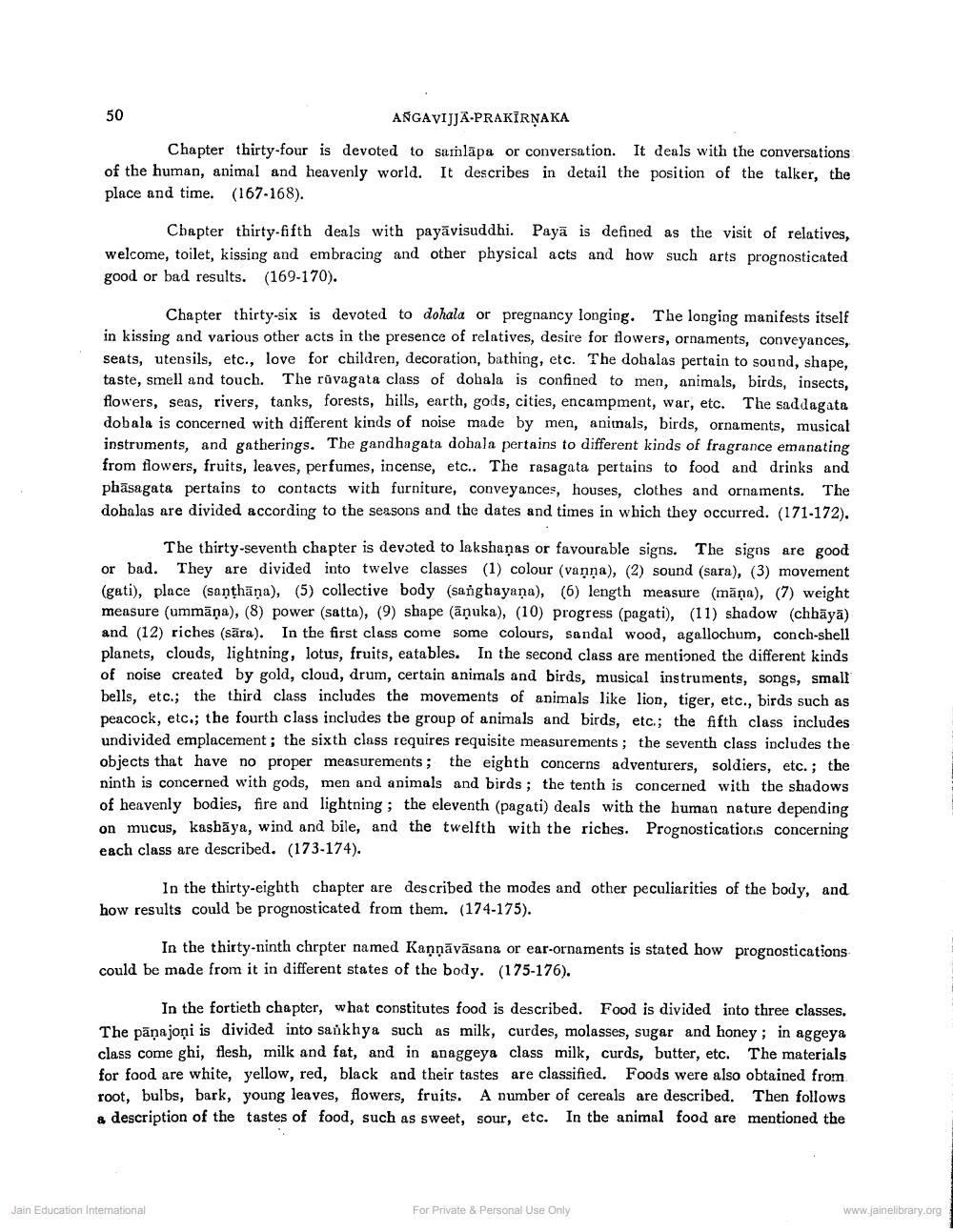________________
50
ASGAVIJJA-PRAKĪRŅAKA
Chapter thirty-four is devoted to samlapa or conversation. It deals with the conversations of the human, animal and heavenly world. It describes in detail the position of the talker, the place and time. (167-168).
Chapter thirty-fifth deals with payavisuddhi. Payā is defined as the visit of relatives, welcome, toilet, kissing and embracing and other physical acts and how such arts prognosticated good or bad results. (169-170).
Chapter thirty-six is devoted to dohala or pregnancy longing. The longing manifests itself in kissing and various other acts in the presence of relatives, desire for flowers, ornaments, conveyances, seats, utensils, etc., love for children, decoration, bathing, etc. The dohalas pertain to sound, shape, taste, smell and touch. The ravagata class of dohala is confined to men, animals, birds, insects, flowers, seas, rivers, tanks, forests, hills, earth, gods, cities, encampment, war, etc. The saddagata dobala is concerned with different kinds of noise made by men, animals, birds, ornaments, musical instruments, and gatherings. The gandhagata dohala pertains to different kinds of fragrance emanating from flowers, fruits, leaves, perfumes, incense, etc.. The rasagata pertains to food and drinks and phasagata pertains to contacts with furniture, conveyances, houses, clothes and ornaments. The dobalas are divided according to the seasons and the dates and times in which they occurred. (171-172).
The thirty-seventh chapter is devoted to lakshanas or favourable signs. The signs are good or bad. They are divided into twelve classes (1) colour (vanna), (2) sound (sara), (3) movement (gati), place (sanṭhāna), (5) collective body (sanghayana), (6) length measure (mana), (7) weight measure (ummāņa), (8) power (satta), (9) shape (āņuka), (10) progress (pagati), (11) shadow (chhāyā) and (12) riches (sāra). In the first class come some colours, sandal wood, agallochum, conch-shell planets, clouds, lightning, lotus, fruits, eatables. In the second class are mentioned the different kinds of noise created by gold, cloud, drum, certain animals and birds, musical instruments, songs, small bells, etc.; the third class includes the movements of animals like lion, tiger, etc., birds such as peacock, etc.; the fourth class includes the group of animals and birds, etc.; the fifth class includes undivided emplacement; the sixth class requires requisite measurements; the seventh class includes the objects that have no proper measurements; the eighth concerns adventurers, soldiers, etc.; the ninth is concerned with gods, men and animals and birds; the tenth is concerned with the shadows of heavenly bodies, fire and lightning; the eleventh (pagati) deals with the human nature depending on mucus, kashaya, wind and bile, and the twelfth with the riches. Prognostications concerning each class are described. (173-174).
In the thirty-eighth chapter are described the modes and other peculiarities of the body, and how results could be prognosticated from them. (174-175).
In the thirty-ninth chrpter named Kanṇāvāsana or ear-ornaments is stated how prognostications could be made from it in different states of the body. (175-176).
In the fortieth chapter, what constitutes food is described. Food is divided into three classes. The pāņajoņi is divided into sankhya such as milk, curdes, molasses, sugar and honey; in aggeya class come ghi, flesh, milk and fat, and in anaggeya class milk, curds, butter, etc. The materials for food are white, yellow, red, black and their tastes are classified. Foods were also obtained from root, bulbs, bark, young leaves, flowers, fruits. A number of cereals are described. Then follows a description of the tastes of food, such as sweet, sour, etc. In the animal food are mentioned the
Jain Education International
For Private & Personal Use Only
www.jainelibrary.org




